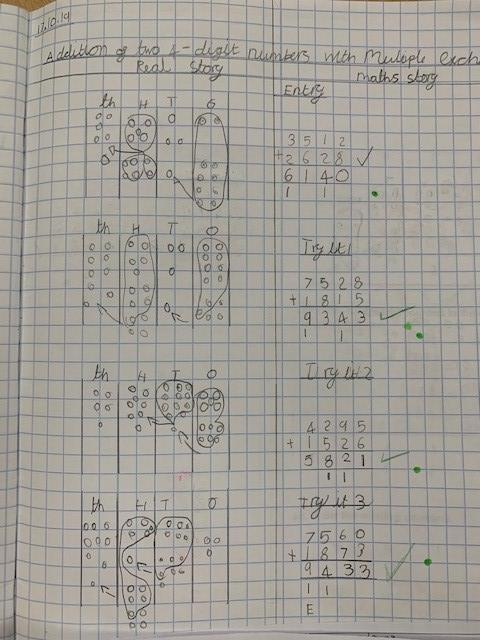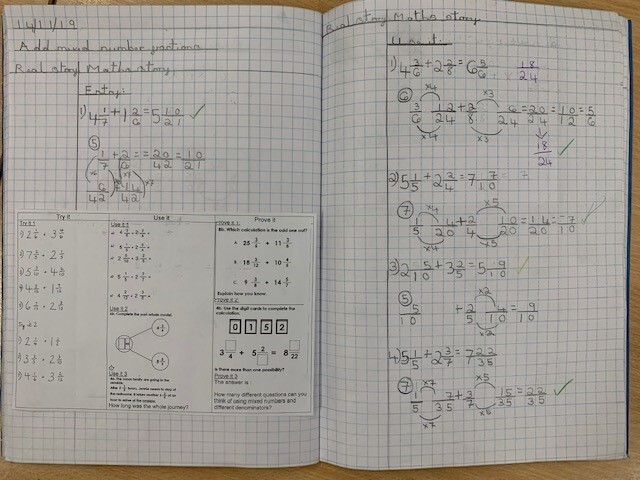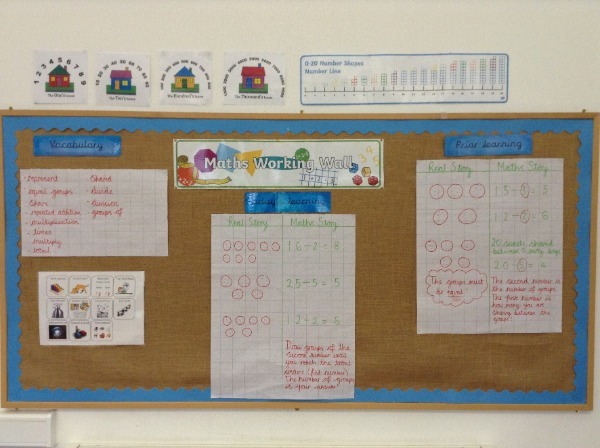Intent
Mathematics teaches children how to make sense of the world around them through developing their ability to calculate, reason and solve problems. It enables children to understand relationships and patterns in both number and space in their everyday lives. Tynings mathematicians are keen calculators, confident problem solvers and inquisitive investigators!
How We Plan and Teach Maths Lessons at The Tynings School – Y1 to Y6
Prior Assessment
Every maths lesson is designed to build upon the prior knowledge of the children, ensuring gaps in understanding are addressed. Before a unit of work is planned, every child in Y1-6 completes an Entry Card which assesses the key skills to be taught in that unit. Here is an example of an Entry Card:
Teachers look carefully at the children’s responses to the questions, and use this information to plan appropriate, effective sequences of learning. Two weeks after the unit has been completed, the children complete an Exit Card. This is the same as the original Entry Card and it is designed to show the progress made by the child, and to identify any gaps in learning which still need to be addressed.
The Daily Lesson Structure
At The Tynings, we use ‘I Do, You Do, We Do’ to model the concepts being taught.
- I Do – a question that the teacher models answering to the children
- We Do – a question for the children to answer in pairs (answer the calculation / odd one out / true or false…)
- You Do – an entry question for children to answer in books to assess their knowledge (answer the calculation / odd one out / true or false…)
The ‘You do’ question is designed to identify the children who are ready to begin working independently. Those who are unable to answer the ‘You Do’ question correctly will receive further support from the teacher.
We use the ‘Try It, Use It, Prove It’ structure when giving the children mathematical activities to complete.
- Try It – skills questions
- Use It – the skill is used in a different context e.g. missing numbers, worded problems…
- Prove It – questions that require deeper thinking e.g. odd one out, explain why, prove why…
Children have a variety of starting points. For example, if a child has already shown a growing understanding of the skill being taught, they will move immediately to the Use It or Prove It, using their skills to problem solve.
An example of a Try It, Use It, Prove It question sheet:
How we teach Mathematics in EYFS
Our teaching of Mathematics is based on the Early Years Curriculum in Reception. Children are guided systematically towards the development of necessary concepts through direct teaching with the whole class (oral, interactive, practical and lively), group activities and individual work.
White Rose Maths

All teachers from EYFS to Y6 use the White Rose scheme of work. It details what the children should be taught for each block of work.
Click here to view the schemes of work for EYFS
Click here to view the schemes of work for pupils in Years 1-6
We also use the White Rose Calculation Policies. This means we have a consistent, progressive approach throughout the school.
Click here to view the White Rose Calculation Policies
Click here to view the calculation policy guidance
Concrete, Pictorial, Abstract (CPA)
At The Tynings, we use a CPA approach to mathematics. Every new concept is learned first with a concrete (physical) experience in ALL year groups and for children of ALL abilities. This helps to bring abstract concepts to life. This could be a short activity at the beginning of the lesson, or it could be a series of lessons in itself. A range of manipulatives are used within the ‘concrete’ phase. This may include Numicon, Base 10, counters, cubes, or anything else that the children can physically manipulate. Teachers use manipulatives when modelling concepts to children. Manipulatives are available to all children at all times and they are displayed / stored so that the children can access them as needed.
Once children are secure with the concrete stage, they can progress to the pictorial stage. The pictorial stage is a vital step for enabling children to move from concrete maths to abstract maths. During the pictorial stage staff help children to make a mental connection between the physical object and abstract levels of understanding by drawing pictures, circles, diagrams or models which represent the objects in the problem. Building or drawing a model makes it easier for children to grasp concepts they traditionally find more difficult, such as fractions, as it helps them visualise the problem and make it more accessible.
Once the pupils have mastered maths concepts through using concrete and pictorial resources, they move into the abstract stage. Even when working abstractly in maths all pupils have access to concrete and pictorial resources to support them.
When recording maths learning, the pages in the exercise books are divided vertically into half. The left hand side of the page is used to record the real story and the right hand side is used to record the maths story. The real story is pictorial representations of the manipulatives used (or could have been used). The maths story is purely number. The children do not need to divide their page if there is no clear mathematical reason to do so (for example, when learning about 2D shapes).
Examples of our Work:
Year 1:
Maths Working Walls
In every classroom we have a maths working wall. They are used to display key vocabulary for the mathematics unit being taught and to display modelled examples. They are designed to help children independently access their learning.
Year 2 working wall
Marking Stations
Children in Key Stage Two use marking stations in their maths lessons. Children regularly visit the marking stations throughout every maths lesson to independently assess their understanding. Children use pink and green pencil crayons to mark their work, and a purple pen to complete corrections. As well as giving children very rapid feedback, it allows teachers and teaching assistants to swiftly provide bespoke support within the lesson for pupils who require it.
Maths Fluency Sessions
In addition to the daily maths lesson, all children in Years 1-6 participate in a daily maths fluency session. This is a short (10-15 minute) session which develops fluency in number facts. It focuses on using understanding of mathematical relationships, making connections between what is known and unknown. It is also an opportunity to recap previous learning and to revisit concepts that children may need further reinforcing.
The Maths Lead at The Tynings School is Jason Stanton. The governor with responsibility for Maths is Claire Rogers. Please do not hesitate to contact us if you have any questions about Maths at The Tynings School.













